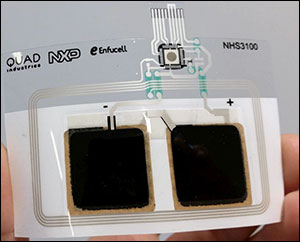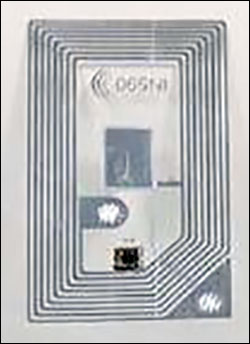The following are news announcements made during the past week by the following organizations:
NXP Semiconductors, Enfucell, Quad Industries;
BI Intelligence, Business Insider;
Lab ID;
GS1 US;
CenTrak; and
STMicroelectronics.
NXP, Enfucell Unveil Biopharmaceutical Cold Chain Monitoring Solution
NXP Semiconductors has developed a battery-powered Near Field Communication (NFC) chip for temperature logging—the NHS3100. The NHS3100 integrates a temperature sensor accurate to 0.3 degrees Celsius, an NFC interface, a real-time clock (RTC), a non-volatile temperature logging memory and an ARM programmable Cortex M0+ processor. To showcase the chip, NXP and Enfucell have jointly developed a disposable temperature-logging foil demonstrator designed to help track and monitor biopharmaceutical products (vaccines, hormones and blood) as they move through the cold chain, from production to administration. Not yet commercially available, the NHS3100 will be launched later this year, with mass-production planned for year’s end.
Typically, cold chain monitoring is performed using either chemical temperature loggers or reusable electronic loggers—but according to the two companies, both are inadequate. Chemical temperature loggers can detect only simple cold chain excursions, and do not indicate when an event occurred. Reusable electronic loggers are expensive and bulky, and are thus deployed only at the pallet level, and not at the item level. Moreover, they are cumbersome to recycle.
This new disposable temperature-logging foil demonstrator supports logging functionality similar to that of a reusable logger, according to NXP and Enfucell, but with a form factor and product cost that enable item-level logging. The foil contains NXP’s NHS3100 IC, Enfucell’s printed battery and a printed NFC antenna. The substrate is composed of flexible, thin PET plastic foils, and the connecting surfaces and the NFC antenna are screen-printed onto it, with the chip bonded to the foil. The Enfucell battery is printed between two PET foils by Quad Industries, which also printed the antenna and the conductive circuitry onto the foil and performed chip-on-flex assembly. The prototype foil is about the size of a business card—8.5 centimeters by 3.5 centimeters (3.3 inches by 1.4 inches)—but NXP says it expects customers will be able to optimize the foil’s size without having to change the functionality and logging interval.
The NHS3100’s programmable architecture offers biopharmaceutical manufacturers the option of defining a product-specific temperature excursion limit profile, the companies reports. Different from the simple caloric model used in chemical loggers, they explain, the more elaborate profile can minimize product waste in the logistic chain say. The internal time reference offers traceability across the logistics chain of exposure beyond excursion limits. The embedded NFC interface supports readout of the product’s status by means of an NFC-enabled smartphone or reader, at any point in the logistic chain, or by medical personnel administering the product.
While similar to NXP’s NTAG 1²C chip (see NXP Announces Commercial Release of NTAG I²C Chip)—because they both include wireless NFC and connected I²C serial interfaces>)—the NHS3100 chip is more of a specialty package, with an integrated microcontroller, a temperature sensor and an RTC. This is particularly well suited for applications requiring temperature-sensing capabilities, NXP notes, and for which the integrated microcontroller is an acceptable option. There are, however, myriad applications in which the design calls for connection to an existing microcontroller, or for which a temperature sensor is not required; more often than not, a simple bidirectional tag or “modem” is more than sufficient, NXP reports, and the existing NTAG I²C serves that building-block requirement well.
Enfucell’s battery technology offers a thin, flexible and eco-friendly power source, NXP and Enfucell add, which can be printed onto the flexible foil. The demonstrator’s battery capacity, along with the ultra-low-power characteristics of the NHS3100, offers a shelf life of one year and supports active logging for two years following activation.
The temperature-logging foil solution is designed to help reduce biopharmaceutical waste, increase the safety and efficacy of biopharmaceutical products, and provide visibility when and where the product was handled incorrectly. The foil can be used as a starting point for a flexible temperature-logging tag. While the disposable temperature-logging foil demonstrator is not yet commercially available, NXP says it is in early discussions with several potential customers.
Beacons Influence Retail Sales to Grow Tenfold in One Year
While currently accounting for just a tiny portion—less than 0.1 percent—of total retail sales, beacon-triggered messages are expected to directly influence $4.1 billion worth of in-store sales this year for the top 100 U.S. retailers. But that is expected to change dramatically in 2016, when $44.4 billion worth of in-store sales at the top 100 U.S. retailers are expected to be directly influenced by beacon-enabled communications. The findings are part of a new report about the use of beacon technology at large retail companies, released by BI Intelligence, a research service from Business Insider.
According to BI Intelligence, Bluetooth beacons—low-cost devices that communicate with smartphone apps via a 2.4 GHz signal encoded with a unique ID number—are among the most important new mobile technologies helping real-world merchants win back sales. The research firm notes that many retailers have been testing beacons, including Macy’s and Target (see Macy’s Expands RFID and Beacon Deployments), and hundreds of large retail chains are expected to turn those devices on and use them to communicate with mainstream consumers in store.
The research firm reports that many early adopters that opt in to receive beacon-triggered messages will likely be coupon clippers, and cites statistics (from mobile app company Shopkick) indicating that half of beacon-triggered messages currently sent are some form of coupon. Mobile couponing app company RetailMeNot claims that its offers alone influenced $3.5 billion in retail sales in 2013, according to BI Intelligence.
In addition, the firm reports that loyalty programs will also be important drivers, noting that beacons and loyalty apps can be used together to reward customers for all sorts of location-based actions, including simply walking into a store. What’s more, BI Intelligence says, brick-and-mortar stores will use mobile-payment apps and in-store technology to establish integrated online and offline loyalty programs among their own customers.
By collecting data regarding consumers’ in-store activities via beacon-powered apps, retailers can also offer highly personalized and targeted offers, which will reinforce couponing and loyalty programs. Moreover, BI Intelligence indicates, some retailers are explicitly using in-store signs and promotions to encourage shoppers to download apps and opt in to beacon campaigns. For example, video game retailer GameStop is experimenting with prominently displaying beacons in stores, so that shoppers can voluntarily wave their smartphone in front of them to receive some type of offer or information.
LAB ID NFC Tags Prove Authenticity for New, Limited-Edition Art
LAB ID, a provider of products and solutions based on RFID technology, has announced that its Near Field Communication (NFC) tags are being used to protect limited-edition art objects, known as BBooks, which are composed of precious woods sculpted and pieced together into spheres. Hidden inside each sphere is the printed parchment of a book.
In order to protect these book collections from being counterfeited, LAB ID teamed up with Italian company Mazelab to develop an NFC-based certificate of authenticity. The certificate system leverages LAB ID’s ISO 14443-compliant inlay, the IN590, which is equipped with NXP Semiconductors‘ Mifare Ultralight EV1 chip. The inlay is incorporated into the sphere’s wooden structure so that it cannot be removed. There are three tags in each sphere, each of which contains information about the BBook. Mazelab developed a smartphone application; the NFC capability in a smartphone reads the three tags, and the app processes the combination of data included in those three tags to confirm the object’s authenticity.
The series of BBook collections is called “Gaia” (which means Earth, in reference to the BBook collection’s spherical shapes, but also referring to the primal goddess of Greek mythology, according to LAB ID). The first sphere in the series incorporates “Poesie in Bianco e Nero,” a collection of 40 poems by Bianca Curioni. The other titles selected for the series include “Flatland: A Romance of Many Dimensions,” by Edwin Abbott; “Alice’s Adventures in Wonderland,” by Lewis Carroll; “Psyche and Cupido,” by Apuleius; “The Prince,” by Machiavelli; “Inferno,” by Dante Alighieri; “On the Duty of Civil Disobedience,” by Henry David Thoreau; “De Brevettate Vitae,” by Seneca; “I Canti,” by Leopardi; and “The Tragedy of Hamlet,” by William Shakespeare.
LAB ID’s work with the BBooks follows another publishing project in which the company participated. Its NFC tags were used in a long graphic novel titled “Golem,” by artist and designer LRNZ and edited by Bao Publishing. The tags were applied to the book’s cover and could be read by smartphones. With a corresponding app, users could then discover new content for the novel, such as parallel stories of the characters, as well as videos and comics.
New GS1 US Advisory Services Program Offers Customized GS1 Standards Implementation Guidance
Nonprofit standards organization GS1 US has announced a new GS1 US Advisory Services program designed to provide GS1 US members with customized technical and business expertise to address their unique GS1 standards implementation challenges. GS1’s standards, according to the organization, uniquely identify products, services, assets and locations worldwide, in order to support global supply chain visibility and efficiency.
The GS1 US Advisory Services program offers consultations, training and educational materials to provide GS1 standards implementation guidance specific to a company’s needs. The program can help with implementing GS1’s US National Data Quality Program, assisting medical device companies with the implementation of GS1 standards to support unique device identification (UDI), and providing standards implementation guidance to the food-service industry, among other needs. Services may also include business process mapping and analytics, data governance assessment and guidance, individualized education and training, and the development of effective supplier on-boarding processes for GS1 standards integration.
The program is available to GS1 US members in a variety of industries. After a company has identified a business process challenge that requires GS1 US Advisory Services support, the organization develops a targeted plan of action, including customized training, to address those standards-implementation obstacles.
CenTrak Adds Bluetooth Capability to RTLS Platform
CenTrak, a provider of real-time locating systems (RTLS), has announced that it has added Bluetooth Low Energy (BLE) capability to its Clinical-Grade Visibility platform, an RTLS designed for health-care providers to track assets, patients and personnel. The patent-pending, fully integrated BLE feature enables communication between nonproprietary Bluetooth devices and the platform, enabling customers to leverage BLE technology in their Clinical-Grade Visibility implementations.
According to CenTrak, the specifics of how BLE has been integrated into the CenTrak RTLS infrastructure are being shared with solution providers that have expressed an interest in leveraging this capability. Many attributes of the BLE standard will be available to end users utilizing CenTrak’s RTLS, through valuable applications offered by CenTrak’s solution partners. However, CenTrak is not at liberty to provide any additional details. “We want to be respectful of their request to allow them to make announcements in accordance with their sales and marketing programs,” says Adam Peck, CenTrak’s senior director of marketing.
In keeping with CenTrak’s open architecture philosophy, the company reports, partners and end users can use the BLE technology alongside many other technologies, such as Wi-Fi and passive ultrahigh-frequency (UHF) or low-frequency (LF) RFID tags and readers. CenTrak has organized an efficient upgrade path for the more than 550 health-care facilities currently utilizing its Clinical-Grade RTLS in North America, Asia, Europe and the Middle East. According to the company, several installations using the new Bluetooth technology are occurring this month.
STMicroelectronics Intros NFC RFID Chips for Applications Such as Smart Signs, Bluetooth Pairing
STMicroelectronics has announced new Near Field Communication (NFC) RFID chips designed for short-range wireless connectivity in consumer electronics, computer peripherals, home appliances, industrial automation and health-care products.
The new SRTAG family of chips supports the NFC Forum‘s Type 4 and NFC Data Exchange Format (NDEF) standards. The SRTAG series offers embedded EEPROM memory ranging from 512 bits to 64 kilobits, which STMicroelectronics says covers a spectrum of applications including NFC smart posters and advertising, image-enhanced NFC business cards, NFC tokens for automated Bluetooth pairing and secure access to Wi-Fi networks, as well as NFC tags for asset tracking, maintenance records, and product identification.
The SRTAG series features a user-programmable digital CMOS output that eliminates the need for an external component to trigger the host wake-up. The tags also feature data retention capability of 200 years (20 times higher than the industry standard, according to the company) and 1 million erase-write cycles (10 times higher than the industry standard, STMicroelectronics reports). In addition, the SRTAG series offers an extended temperature range from -40 degrees to +85 degrees Celsius (-40 degrees to +185 degrees Fahrenheit) and couples 128-bit password protection with a 20-bit counter for read-write access control that, according to STMicroelectronics, virtually eliminates any risk of tag cloning or tampering.
The SRTAG16K, with 16 kilobits of memory, and SRTAG64K, with 64 kilobits of memory, are both available in production volumes, while the SRTAG2KL, SRTAG2KL-P and SRTAG512L models are currently sampling to lead customers. Prices for orders of 1,000 pieces start at $0.17 apiece for the 512-bit version.




